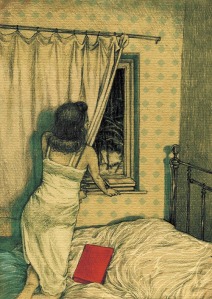Are there parallels between building character – as in becoming a mature, evolved human being – and building character, as in creating an interesting protagonist for your story?
David Brooks is talking about that first kind of character building in his book, The Road to Character. But I wonder how his ideas might relate to the work we do when creating story characters. I am especially interested in what he calls the “agency moment,” and how that might apply to characters in picture books. Does a story character’s agency moment provide a compass for the plot?
Brooks uses the example of Victorian novelist George Eliot to introduce this idea of the agency moment. Eliot, he says, was an emotionally needy young woman in her 20s who declared her love to the philosopher Herbert Spencer at age 32 in a letter:
“Those who have known me best have already said that if ever I loved any one thoroughly, my whole life must turn upon that feeling, and I find they said truly,” she wrote.
She asked him not to forsake her, “If you become attached to someone else, then I must die, but until then I could gather courage to work and make life valuable, if only I had you near me. I do not ask you to sacrifice anything — I would be very glad and cheerful and never annoy you.”
Brooks writes, “You might say that this moment was Eliot’s agency moment, the moment when she stopped being blown about by her voids and weaknesses and began to live according to her own inner criteria, gradually developing a passionate and steady capacity to initiate action and drive her own life.
“The letter didn’t solve her problems. Spencer still rejected her. She remained insecure, especially about her writing. But her energies were roused. There was growing cohesion and, at times, amazing courage.”
She published Middlemarch at age 52 in eight parts, 1871-72.
I searched my library for examples of agency moments to see how that notion plays out in picture books.
Marion Dane Bauer’s Winter Dance, illustrated by Richard Jones, revolves around a fox’s question, “Winter is coming…What should I do?” The fox asks caterpillar, turtle, bat, geese and bear. But she is sure what works for them will not work for her. Then a fellow fox offers a solution: “When a million snowflakes fill the air, twirling, tumbling, spinning, waltzing, you and I join them.” The questing fox has an agency moment, tapping into her innate capacity to initiate action and drive her own life. She responds:
“Of course,” says the fox, standing tall. “Because that’s what we fine red foxes do in winter. Dance!”
A moment of agency is front and center in fellow-BATT blogger Margaret Chodos Irvine’s Ella Sarah Gets Dressed. Ella Sarah states her wardrobe choices very clearly on the first page: “I want to wear my pink polka-dot pants, my dress with orange-and-green flowers, my purple-and-blue striped socks my yellow shoes, and my red hat.” Other family members’ suggestions are spurned
and her choices are confirmed by her just-as-wildly dressed friends who visit at the end.
In my own Little Wolf’s First Howling, illustrated with my sister Kate Harvey McGee, Little Wolf’s agency moment comes at the turning point of the story. “Little Wolf’s heart swelled with wildness and joy. He knew it wasn’t proper howling form, built he had to let loose.”
Seems related to David Brooks’ explanation: “Agency is not automatic. It has to be given birth to, with pushing and effort. It’s not just the confidence and drive to act. It’s having engraved inner criteria to guide action.”
In Libba, Laura Viers’ picture book biography of folksinger Elizabeth Cotten, illustrated by Tatyana Fazlalizadeh, the agency moment comes early in the story, early in Libba’s life, when she sneaks into her brother’s room and figures out how to play his guitar, though she is left-handed. “She turned the guitar upside down and played it backwards…Nobody else played that way, but it was the way that felt right to Libba.”
I polled various friends and family to see if they could point to a single agency moment in their lives. Several thought it would need to be something big. And not one could point to just one moment. This is true in my own experience, as well. It is many small moments that coalesce over time, viewed retrospectively, that shape our true and, hopefully, evolved selves.
When creating a story, however, you have the luxury to choose your character’s agency moment in a way that reveals the most compelling narrative.
Here’s to Happy 2020 dear BATT readers! Come January, the five of us have taken turns posting here for eight years. Eight years! We appreciate your reading and sharing your thoughts in the comments discussion.






















































